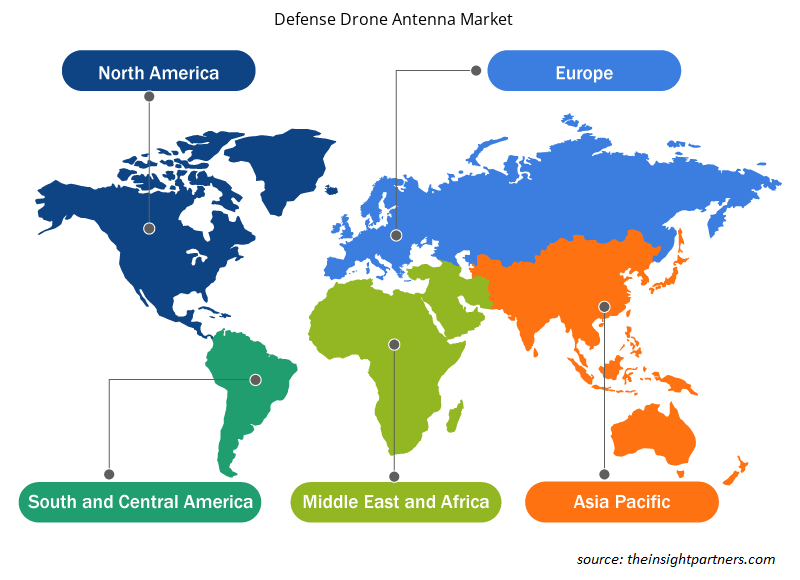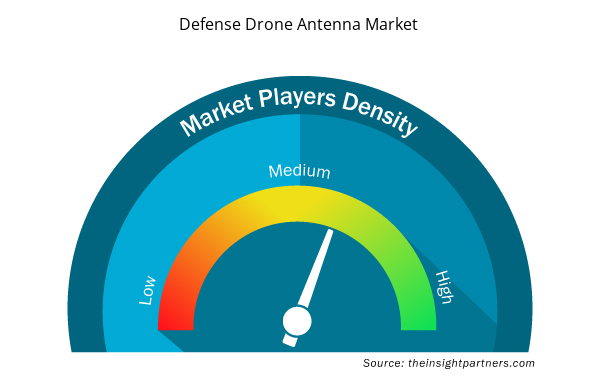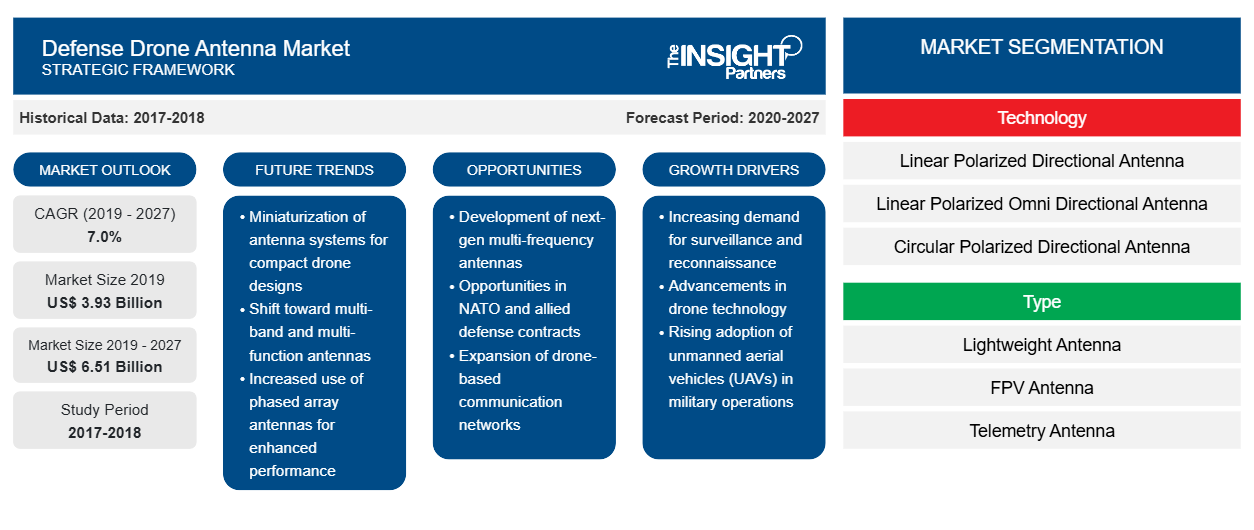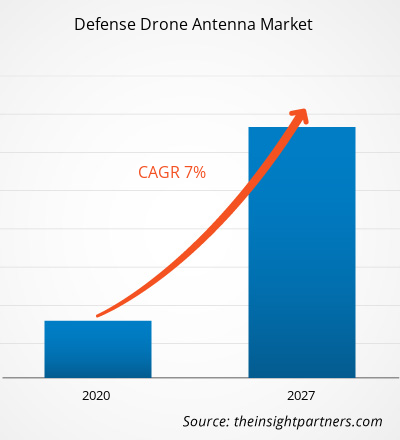En términos de ingresos, el mercado global de antenas para drones de defensa se valoró en US$ 3.925,61 millones en 2019 y se proyecta que alcance los US$ 6.505,28 millones para 2027; se espera que crezca a una CAGR del 7,0% durante el período de pronóstico de 2020 a 2025.
El mercado de antenas para drones de defensa está segmentado en cinco regiones principales: América del Norte, Europa, Asia Pacífico, Oriente Medio y África y SAM. América del Norte domina el mercado de vehículos aéreos no tripulados militares, por lo que la demanda de antenas para drones de defensa en la región es alta. Los actores y el gobierno de los EE. UU. están invirtiendo significativamente en I+D relacionado con los vehículos aéreos no tripulados militares. Aparte de esto, las colaboraciones entre los gigantes de la industria, junto con las crecientes inversiones en el desarrollo de vehículos aéreos no tripulados tecnológicamente avanzados para respaldar muchas aplicaciones militares, acelerarían la demanda de vehículos aéreos no tripulados militares en los EE. UU.
Personalice este informe según sus necesidades
Obtendrá personalización en cualquier informe, sin cargo, incluidas partes de este informe o análisis a nivel de país, paquete de datos de Excel, así como también grandes ofertas y descuentos para empresas emergentes y universidades.
- Obtenga las principales tendencias clave del mercado de este informe.Esta muestra GRATUITA incluirá análisis de datos, desde tendencias del mercado hasta estimaciones y pronósticos.
Perspectivas de mercado: mercado de antenas para drones de defensa
Creciente interés en las antenas omnidireccionales circulares
Las fuerzas militares utilizan tecnologías no tripuladas para fines tales como vigilancia, comunicaciones, navegación e inteligencia de señales (SIGINT). Las fuerzas militares buscan continuamente tecnologías avanzadas con el objetivo de mejorar las capacidades de los vehículos no tripulados. Las antenas omnidireccionales polarizadas lineales se encuentran entre las tecnologías de antena preferidas. Sin embargo, la preferencia por las antenas omnidireccionales polarizadas circulares está aumentando a un ritmo exponencial. Los drones militares modernos necesitan moverse o maniobrar constantemente para recopilar mayores volúmenes de información; por lo tanto, a veces necesitan adoptar un vuelo acrobático. Las antenas circulares son más pequeñas, lo que ofrece una ventaja adicional para una fácil maniobrabilidad. Además del tamaño de antena más pequeño, la capacidad de transmitir los datos recopilados en 360 ° está generando interés en las fuerzas de defensa, así como en los fabricantes de drones de defensa. Además, las fuerzas militares exigen una calidad excepcional de datos e imágenes capturados entre las fuerzas militares, y estas antenas facilitan la transmisión de imágenes de alta calidad durante el vuelo del dron muy cerca del objetivo. Estos beneficios de las antenas omnidireccionales circulares están contribuyendo al crecimiento del mercado de antenas para drones de defensa.
Perspectivas del segmento tecnológico
En términos de tecnología, el segmento de antenas omnidireccionales polarizadas lineales dominó el mercado global de antenas para drones de defensa en 2019. Las antenas lineales proyectan una onda a lo largo de un único plano, horizontal o vertical. Este tipo de polarización facilita la transmisión de más energía, ya que la onda simplemente se mueve en una dirección.
Información sobre segmentos de tipo
En cuanto al tipo, el segmento de antenas ligeras dominó el mercado mundial de antenas para drones de defensa en 2019. Los UAV más pequeños y livianos se están utilizando de manera significativa para aplicaciones de inteligencia y comunicaciones más complejas. Para aumentar la capacidad de merodeo y la persistencia de estos vehículos, existe una creciente demanda de antenas más livianas y aerodinámicas.
Información sobre segmentos de frecuencia
En cuanto a la frecuencia, el segmento de frecuencia ultraalta dominó el mercado mundial de antenas para drones de defensa en 2019. Las antenas de frecuencia ultraalta (UHF) operan con un rango de frecuencia superior a 300 MHz. En el escenario actual, UHF es la banda de frecuencia más utilizada.
Información sobre segmentos de aplicaciones
Según la industria, el segmento de comunicaciones dominó el mercado global de antenas para drones de defensa en 2019. Los fabricantes de UAV están enfatizando continuamente la integración de sistemas de comunicación de última generación con el objetivo de facilitar que el personal militar en la estación base se comunique con el UAV. Para integrar los mejores sistemas de comunicación, la necesidad de una antena de comunicación es de suma importancia. Atribuyendo al hecho de que la antena de comunicación en un UAV es importante, se anticipa que la demanda de la antena se mantendrá alta durante todo el período de pronóstico.
Los actores del mercado se centran en innovaciones y desarrollos de nuevos productos integrando tecnologías y características avanzadas en sus productos para competir con los competidores.
- En 2020, PPM anunció la apertura de 40 nuevas oficinas en el Reino Unido para ampliar su trabajo de ingeniería y diseño, ventas y marketing, servicio al cliente y contabilidad.
- En 2020, Southwest Antennas presentó dos nuevas antenas omnidireccionales para su uso en aplicaciones de banda UHF e ISM. Son ideales para sistemas de radio tácticos, receptores de video portátiles, sistemas de radio MIMO y MANET, plataformas robóticas no tripuladas y otras aplicaciones. Las nuevas antenas vienen con base de resorte sellada Ultra-Flex o base de cuello de cisne flexible.
Perspectivas regionales del mercado de antenas para drones de defensa
Los analistas de Insight Partners explicaron en detalle las tendencias y los factores regionales que influyen en el mercado de antenas para drones de defensa durante el período de pronóstico. Esta sección también analiza los segmentos y la geografía del mercado de antenas para drones de defensa en América del Norte, Europa, Asia Pacífico, Oriente Medio y África, y América del Sur y Central.

- Obtenga datos regionales específicos para el mercado de antenas para drones de defensa
Alcance del informe de mercado de antenas para drones de defensa
| Atributo del informe | Detalles |
|---|---|
| Tamaño del mercado en 2019 | US$ 3.93 mil millones |
| Tamaño del mercado en 2027 | 6.510 millones de dólares estadounidenses |
| CAGR global (2019-2027) | 7.0% |
| Datos históricos | 2017-2018 |
| Período de pronóstico | 2020-2027 |
| Segmentos cubiertos | Por tecnología
|
| Regiones y países cubiertos | América del norte
|
| Líderes del mercado y perfiles de empresas clave |
|
Densidad de actores del mercado: comprensión de su impacto en la dinámica empresarial
El mercado de antenas para drones de defensa está creciendo rápidamente, impulsado por la creciente demanda de los usuarios finales debido a factores como la evolución de las preferencias de los consumidores, los avances tecnológicos y una mayor conciencia de los beneficios del producto. A medida que aumenta la demanda, las empresas amplían sus ofertas, innovan para satisfacer las necesidades de los consumidores y aprovechan las tendencias emergentes, lo que impulsa aún más el crecimiento del mercado.
La densidad de actores del mercado se refiere a la distribución de las empresas o firmas que operan dentro de un mercado o industria en particular. Indica cuántos competidores (actores del mercado) están presentes en un espacio de mercado determinado en relación con su tamaño o valor total de mercado.
Las principales empresas que operan en el mercado de antenas para drones de defensa son:
- Compañía: Alaris Holdings Ltd.
- Corporación Antcom
- Asociados de investigación de antenas, Inc.
- Cobham Sociedad Anónima
- Ingeniería JEM
Descargo de responsabilidad : Las empresas enumeradas anteriormente no están clasificadas en ningún orden particular.

- Obtenga una descripción general de los principales actores clave del mercado de antenas para drones de defensa
El mercado global de antenas para drones de defensa se ha segmentado de la siguiente manera:
Mercado de antenas para drones de defensa: por tecnología
- Antena direccional polarizada lineal
- Antena omnidireccional polarizada lineal
- Antena direccional polarizada circular
- Antena omnidireccional polarizada circular
Mercado de antenas para drones de defensa: por tipo
- Antena ligera
- Antena FPV
- Antena de telemetría
- Antena NLOS
- Otros
Mercado de antenas para drones de defensa: por frecuencia
- Frecuencia alta
- Muy alta frecuencia
- Frecuencia ultraalta
Mercado de antenas para drones de defensa: por aplicación
- Vigilancia
- Navegación
- Comunicación
- Telemetría
- Otros
Mercado de antenas para drones de defensa: por región
- América del norte
- A NOSOTROS
- Canadá
- México
- Europa
- Francia
- Alemania
- Italia
- España
- Suiza
- Reino Unido
- Resto de Europa
- Asia Pacífico (APAC)
- Porcelana
- India
- Corea del Sur
- Singapur
- Japón
- Australia
- Resto de APAC
- Oriente Medio y África (MEA)
- Sudáfrica
- Arabia Saudita
- Emiratos Árabes Unidos
- Resto de MEA
- América del Sur (SAM)
- Brasil
- Resto de SAM
Mercado de antenas para drones de defensa: perfiles de empresas
- Compañía: Alaris Holdings Ltd.
- Corporación Antcom
- Asociados de investigación de antenas, Inc.
- Cobham Sociedad Anónima
- Ingeniería JEM
- Antena MP, LTD
- Sistemas PPM
- Antenas del suroeste, Inc.
- Conectividad TE
- Empresa
- Análisis histórico (2 años), año base, pronóstico (7 años) con CAGR
- Análisis PEST y FODA
- Tamaño del mercado Valor/volumen: global, regional, nacional
- Industria y panorama competitivo
- Conjunto de datos de Excel


- Medical Enzyme Technology Market
- Smart Locks Market
- Sleep Apnea Diagnostics Market
- Health Economics and Outcome Research (HEOR) Services Market
- Foot Orthotic Insoles Market
- 3D Mapping and Modelling Market
- Diaper Packaging Machine Market
- Virtual Event Software Market
- Rugged Servers Market
- Virtual Pipeline Systems Market

Report Coverage
Revenue forecast, Company Analysis, Industry landscape, Growth factors, and Trends

Segment Covered
This text is related
to segments covered.

Regional Scope
North America, Europe, Asia Pacific, Middle East & Africa, South & Central America

Country Scope
This text is related
to country scope.
Preguntas frecuentes
The linear polarized omni directional antenna segment led the technology segment. The linear antennas project a wave along a singular plane, horizontal or vertical. This kind of polarization facilitates more energy to be transmitted, as the wave simply moves in one direction. However, penetration of obstacles is reduced pertaining to the difficulty a linear wave faces in navigating around an object that is present in its plane of propagation. On the other hand, omnidirectional antennas are best suitable for the radiation of a signal in all possible directions, but over a comparatively shorter range. The radiation pattern can be clearly captured in the omnidirectional antennas as being particularly well dispersed in all the directions covering the antenna apart from directly below and above the antenna. These antennas are mainly utilized with the video transmitter, as the antennas are well adapted to overcome unexpected changes in the direction and attitude of an aircraft’s flight.
North America is expected to be the largest revenue generator in the defense drone antenna market compared to the other regions. The US Department of Defense (DoD) is anticipated to increase its UAV spending in the next few years to prepare the military for high-end fights against advanced rivals. There was an inclusion of the spending of US$ 3.7 billion on new unmanned systems technology in the president defense budget request for FY 2020. According to the dean of the Mitchell Institute for Aerospace Studies, the US military has enormous opportunities to use UAVs more commonly in various applications, including cargo aircraft and combat aircraft. The growing demand for drones for military application in North America is expected to drive the growth of defense drone antenna market.
A rapidly changing modern warfare has been urging governments of various countries to allocate higher amounts toward the respective military forces. The military budget allocation enables the military forces to procure advanced technologies and equipment from national or international manufacturers. On the same lines, solider and military vehicle modernization practices are also on rise in many countries. The procurement of drones or unmanned aerial vehicles (UAVs) is a major part of this modernization strategy. In addition, the defense ministries worldwide are investing substantial amounts in newer technologies, including contemporary UAVs or unmanned aircraft systems (UAS). Surge in orders for the drones or UAVs or UASs from the defense forces signifies a substantial demand for drone antennas, which is driving the defense drone antenna market.
Trends and growth analysis reports related to Aerospace and Defense : READ MORE..
The List of Companies - Defense Drone Antenna Market
- Alaris Holdings Ltd.
- Antcom Corporation
- Antenna Research Associates, Inc.
- Cobham Plc
- JEM Engineering
- MP Antenna, LTD
- PPM Systems
- Southwest Antennas, Inc.
- TE Connectivity
- Trimble Inc.
The Insight Partners performs research in 4 major stages: Data Collection & Secondary Research, Primary Research, Data Analysis and Data Triangulation & Final Review.
- Data Collection and Secondary Research:
As a market research and consulting firm operating from a decade, we have published and advised several client across the globe. First step for any study will start with an assessment of currently available data and insights from existing reports. Further, historical and current market information is collected from Investor Presentations, Annual Reports, SEC Filings, etc., and other information related to company’s performance and market positioning are gathered from Paid Databases (Factiva, Hoovers, and Reuters) and various other publications available in public domain.
Several associations trade associates, technical forums, institutes, societies and organization are accessed to gain technical as well as market related insights through their publications such as research papers, blogs and press releases related to the studies are referred to get cues about the market. Further, white papers, journals, magazines, and other news articles published in last 3 years are scrutinized and analyzed to understand the current market trends.
- Primary Research:
The primarily interview analysis comprise of data obtained from industry participants interview and answers to survey questions gathered by in-house primary team.
For primary research, interviews are conducted with industry experts/CEOs/Marketing Managers/VPs/Subject Matter Experts from both demand and supply side to get a 360-degree view of the market. The primary team conducts several interviews based on the complexity of the markets to understand the various market trends and dynamics which makes research more credible and precise.
A typical research interview fulfils the following functions:
- Provides first-hand information on the market size, market trends, growth trends, competitive landscape, and outlook
- Validates and strengthens in-house secondary research findings
- Develops the analysis team’s expertise and market understanding
Primary research involves email interactions and telephone interviews for each market, category, segment, and sub-segment across geographies. The participants who typically take part in such a process include, but are not limited to:
- Industry participants: VPs, business development managers, market intelligence managers and national sales managers
- Outside experts: Valuation experts, research analysts and key opinion leaders specializing in the electronics and semiconductor industry.
Below is the breakup of our primary respondents by company, designation, and region:

Once we receive the confirmation from primary research sources or primary respondents, we finalize the base year market estimation and forecast the data as per the macroeconomic and microeconomic factors assessed during data collection.
- Data Analysis:
Once data is validated through both secondary as well as primary respondents, we finalize the market estimations by hypothesis formulation and factor analysis at regional and country level.
- Macro-Economic Factor Analysis:
We analyse macroeconomic indicators such the gross domestic product (GDP), increase in the demand for goods and services across industries, technological advancement, regional economic growth, governmental policies, the influence of COVID-19, PEST analysis, and other aspects. This analysis aids in setting benchmarks for various nations/regions and approximating market splits. Additionally, the general trend of the aforementioned components aid in determining the market's development possibilities.
- Country Level Data:
Various factors that are especially aligned to the country are taken into account to determine the market size for a certain area and country, including the presence of vendors, such as headquarters and offices, the country's GDP, demand patterns, and industry growth. To comprehend the market dynamics for the nation, a number of growth variables, inhibitors, application areas, and current market trends are researched. The aforementioned elements aid in determining the country's overall market's growth potential.
- Company Profile:
The “Table of Contents” is formulated by listing and analyzing more than 25 - 30 companies operating in the market ecosystem across geographies. However, we profile only 10 companies as a standard practice in our syndicate reports. These 10 companies comprise leading, emerging, and regional players. Nonetheless, our analysis is not restricted to the 10 listed companies, we also analyze other companies present in the market to develop a holistic view and understand the prevailing trends. The “Company Profiles” section in the report covers key facts, business description, products & services, financial information, SWOT analysis, and key developments. The financial information presented is extracted from the annual reports and official documents of the publicly listed companies. Upon collecting the information for the sections of respective companies, we verify them via various primary sources and then compile the data in respective company profiles. The company level information helps us in deriving the base number as well as in forecasting the market size.
- Developing Base Number:
Aggregation of sales statistics (2020-2022) and macro-economic factor, and other secondary and primary research insights are utilized to arrive at base number and related market shares for 2022. The data gaps are identified in this step and relevant market data is analyzed, collected from paid primary interviews or databases. On finalizing the base year market size, forecasts are developed on the basis of macro-economic, industry and market growth factors and company level analysis.
- Data Triangulation and Final Review:
The market findings and base year market size calculations are validated from supply as well as demand side. Demand side validations are based on macro-economic factor analysis and benchmarks for respective regions and countries. In case of supply side validations, revenues of major companies are estimated (in case not available) based on industry benchmark, approximate number of employees, product portfolio, and primary interviews revenues are gathered. Further revenue from target product/service segment is assessed to avoid overshooting of market statistics. In case of heavy deviations between supply and demand side values, all thes steps are repeated to achieve synchronization.
We follow an iterative model, wherein we share our research findings with Subject Matter Experts (SME’s) and Key Opinion Leaders (KOLs) until consensus view of the market is not formulated – this model negates any drastic deviation in the opinions of experts. Only validated and universally acceptable research findings are quoted in our reports.
We have important check points that we use to validate our research findings – which we call – data triangulation, where we validate the information, we generate from secondary sources with primary interviews and then we re-validate with our internal data bases and Subject matter experts. This comprehensive model enables us to deliver high quality, reliable data in shortest possible time.


 Obtenga una muestra gratuita de este informe
Obtenga una muestra gratuita de este informe